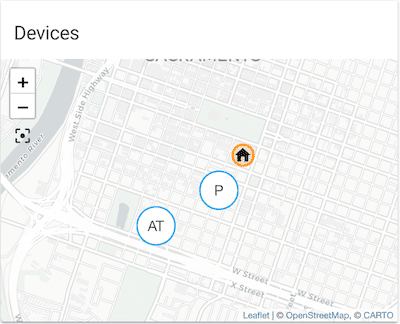Map card
The map card that allows you to display entities on a map. This card is used on the Map dashboard, which is one of the default dashboards.
 Screenshot of the map card.
Screenshot of the map card.
To add the map card to your user interface:
- In the top right of the screen, select the pencil icon.
- If this is your first time editing a dashboard, the Edit dashboard dialog appears.
- By editing the dashboard, you are taking over control of this dashboard.
- This means that it is no longer automatically updated when new dashboard elements become available.
- To continue, in the dialog, select the three dots menu, then select Take control.
- If this is your first time editing a dashboard, the Edit dashboard dialog appears.
- Add a card to your dashboard.
All options for this card can be configured via the user interface.
YAML configuration
The following YAML options are available when you use YAML mode or just prefer to use YAML in the code editor in the UI.
Configuration Variables
List of entity IDs or entity objects (see below). Either this or the geo_location_sources configuration option is required.
List of geolocation sources. All current entities with that source will be displayed on the map. See Geolocation platform for valid sources. Set to all to use all available sources. Either this or the entities configuration option is required.
The map will follow moving entities by adjusting the viewport of the map each time an entity is updated.
Whether the map should consider the zones in the list of specified entities when fitting its viewport.
Forces the height of the image to be a ratio of the width. Valid formats: Height percentage value (23%) or ratio expressed with colon or “x” separator (16:9 or 16x9). For a ratio, the second element can be omitted and will default to “1” (1.78 equals 1.78:1).
The default zoom level of the map.
14 (or whatever zoom level is required to fit all visible markers)
The default_zoom value will be ignored if it is set higher than the current zoom level
after fitting all visible entity markers in the map window. In other words, this can only
be used to zoom the map out by default.
Options for entities
If you define entities as objects instead of strings (by adding entity: before entity ID), you can add more customization and configuration.
Configuration Variables
When set to state, renders the entity’s state as the label for the map marker instead of the entity’s name. This option doesn’t apply to zone entities because they don’t use a label but an icon.
Examples
type: map
aspect_ratio: 16:9
default_zoom: 8
auto_fit: true
entities:
- device_tracker.demo_paulus
- zone.home
type: map
geo_location_sources:
- nsw_rural_fire_service_feed
entities:
- zone.home
type: map
entities:
- device_tracker.demo_paulus
- entity: sensor.gas_station_gas_price
label_mode: state
focus: false
hours_to_show: 48